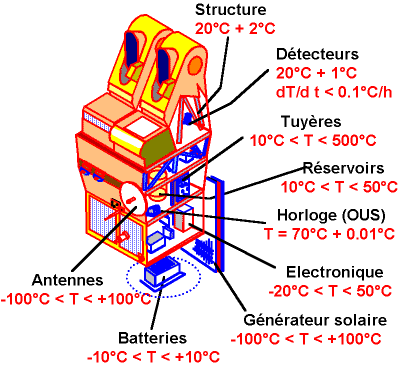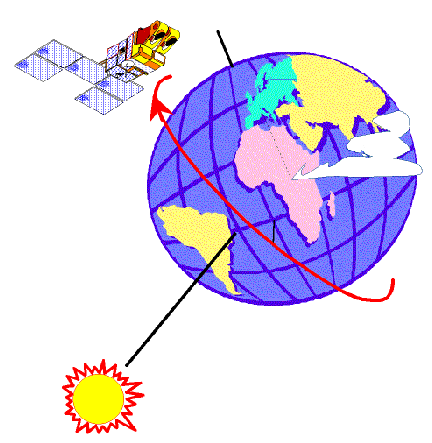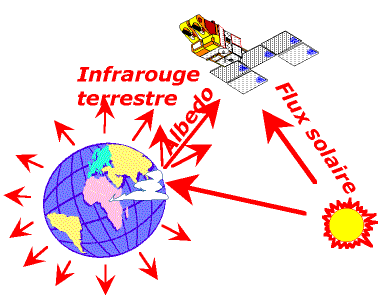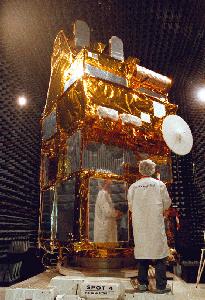
The
purpose of thermal control,
Requirements,
Thermal constraints related to
SPOT 4's orbit,
The thermal environment in orbit,
The satellite's thermal balance,
Internal thermal control arrangement,
Telemetry and Commands,
Development and
qualification of thermal control,
The SPOT 1,
SPOT 2 and SPOT 3 heritage
Throughout the mission, thermal control ensures that each item of equipment is maintained at temperatures consistent with nominal operation.
Most equipment only operates correctly if maintained at the right temperature and if
temperature changes are within acceptable limits. In our terrestrial environment or in
laboratories, temperature is often regulated "naturally".
Satellite environments in orbit are completely different (vacuum, microgravity, radiation,
etc.). This means that thermal conditons are very particular and likely to cause dangerous
changes in temperature. Correct temperature can only be achieved by applying scientific
method and specific "thermal control" technology.
To guarantee normal operation of equipment, thermal control must ensure that an item's temperature remains within predefined limits (specifications):
| Temperature level | - for instance | -20°C < T < +50°C |
| Temperature stability over time | - for instance | dT/dt < 5°C/hour |
| Maximum temperature gradients | - for instance | dT < 5°C for an item of equipment |
The figure below gives examples of temperature specifications for various items of SPOT 4 equipment.

SPOT 4 is on a circular sun-synchronous orbit at an altitude of 830 km with an inclination of 98.8° with respect to the equator.
 The orbital plane turns slowly around the north/south axis (about one degree
per day or one revolution per year). This rotation is synchronized with the Earth's
rotation around the Sun in such a way that the Sun is fixed relative to the orbit, whence
the name of "sun-synchronous." The satellite crosses the equatorial plane from
north to south at 10:30 (local solar time).
The orbital plane turns slowly around the north/south axis (about one degree
per day or one revolution per year). This rotation is synchronized with the Earth's
rotation around the Sun in such a way that the Sun is fixed relative to the orbit, whence
the name of "sun-synchronous." The satellite crosses the equatorial plane from
north to south at 10:30 (local solar time).
The satellite completes one orbital revolution in 101.5 minutes. For two-thirds of the orbital period, i.e. 66 minutes, the satellite is in sunshine and its external surfaces (radiators) are hot, while for 35 minutes it is in the Earth's shadow and cools down.
Due to the extremely low density of the atmosphere at the orbital altitude (20 x 10-14 kg/m3) and because of the microgravity environment, there is no convection. The satellite's temperature is controlled solely by the radiative exchanges with its environment.
The first source of heat is that dissipated by electrical and electronic equipment. The power consumed by the electronic modules is mostly transformed into heat (Joule effect). The only power which does not turn into heat is the useful electromagnetic radiation of the antennas. Operation of orbit control thrusters also produces heat, as do the charging and discharging of batteries.
External radiation which illuminates the satellite's outer surfaces is the second main source of heat. The diagram below illustrates these fluxes.

The direct solar flux outside of the atmosphere is approximately 1375 Watts/m². This radiation is mainly in the visible (90%) and near infrared (10%) bands.
Albedo is the solar flux reflected by the Earth and clouds. Its spectrum is similar to the Sun's with a few absorption bands due to energy passing through the atmosphere and depending on the nature of reflecting surfaces. At SPOT 4's altitude, this flux represents about 300 W/m² at the subsolar point, with an orbital average of 100 W/m² for surfaces facing earthward.
From the thermal point of view, the Earth as seen from space is equivalent to a sphere at approximately -18°C. It continuously emits electromagnetic radiation in the infrared at wavelengths from 10 µm to 12 µm. This represents an incident energy of 190 W/m² on those satellite surfaces which are facing the Earth.
At satellite altitudes the background of the sky is black. Radiation (gamma, X,
ultraviolet, visible, infrared and radio) from deep space represent a very small amount of
energy. Thermally speaking, the sky may be likened to a "cold sink" at
3°Kelvin.
Deep space at 3°K is the main source of cold for satellites.
This radiative environment causes extreme temperature variations in the satellite's " outer skin ". Thus the outside layers of insulating blankets can reach temperatures of 80°C when turned towards the Sun and drop to -200°C when in the shadow of the satellite.
 To maintain the satellite at a mean temperature close to 20°C, a
satisfactory balance has to be achieved between heat sources and cold sinks.
To maintain the satellite at a mean temperature close to 20°C, a
satisfactory balance has to be achieved between heat sources and cold sinks.
This is why radiative areas have been designed on the outside of the satellite. These
radiators are given a special coating, the SSM (Second Surface Mirror) whose
thermo-optical properties allow both for absorbing external fluxes and radiation towards
deep space while maintaining a satisfactory balance.
Surfaces which are not used as radiators are covered by so-called "super- insulating" blankets which are incredibly efficient in the space vacuum (one hundred times better than polystyrene).
In photographs of the satellite, the radiators look like blueish mirrors. The multy-layer insulation has a golden yellow colour due to the use of aluminium-coated polyamide films (Kapton R).
While the radiative surfaces are designed to ensure a satisfactory mean satellite temperature, the thermal control has to be optimized for each item of equipment.
The higher an item's controlled operating temperature and the greater the amount of heat it dissipates, the more strongly it will be coupled to a radiative surface. This coupling will either be conductive (conduction via the satellite's metal structures or a specific path) or radiative between the equipment housing and the satellite's walls.
Naturally this arrangement has to take into account constraints relating to the general architecture of the satellite (functional and mechanical constraints).
During cold mission phases and in particular when the equipment is not very active, it has to be kept warm by heaters. The flight software manages the thermal control system. Temperature measurements recorded by a network of sensors, are compared to reference values. The heaters are then switched on and controlled strictly according to need.
Some items require very precise temperature control. This is the case for gyroscopes or the onboard clock, which are controlled to within a tenth or a hundredth of a degree respectively. To ensure this stability, these components are installed in a fairly cold environment, then heated using a PI (proportional - integral) control law.
In the event of a serious satellite failure (safe-hold mode), the satellite automatically adopts a fixed attitude relative to the Sun and only essential equipment will be powered. A network of electrical heaters controlled by mechanical thermostats (bimetallic strips) are used to maintain an adequate temperature to protect equipment.
Throughout the satellite's operational life, a few hundred sensors (thermistors) located in strategic areas are used to ensure nominal equipment operation. Measurements of the power consumed by heaters gives a precise indication of the state of the satellite.
Temperatures and heater control laws can be changed from the ground. If a heater network fails, a backup network (redundancy) can be switched on.
The thermal control system is designed using detailed numerical modeling of the satellite and requires powerful software for calculating energy fluxes and temperatures.
Modeling is also based on laboratory testing of materials and partial mock-ups.
Before launch, the satellite is tested in a large space environment simulator which is used to reproduce representative conditions of vacuum and temperature.
During the first days in orbit detailed analysis of telemetry determines whether the thermal control is operating as its should and whether regulation limits should be changed.
SPOT 4 uses the same thermal control principles as its predecessors. It has nevertheless been upgraded to incorporate more power, new instruments and new equipment.
Moreover SPOT 1, 2 and 3 thermal telemetry has been analysed to gain more knowledge of the environments encountered by sun-synchronous satellites and to evaluate more precisely the behaviour of materials and systems. Surprisingly, it has been discovered that atomic oxygen which is the major constituent of the residual atmosphere at SPOT's orbital altitude, continuously cleans the outer surfaces of the satellite. Some radiators, which were expected to age rapidly, remained remarkably youthful.
![]()
page updated on the 00-06-06